1.Overview of the Development of New Energy Power Generation
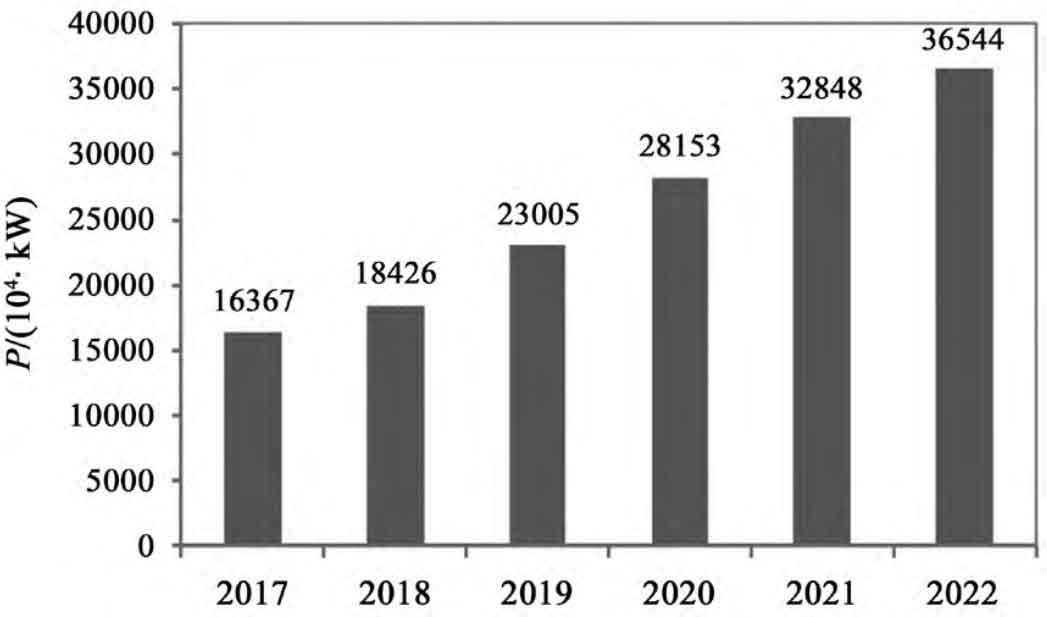
With the continuous and steady progress of the “dual carbon” plan, China’s new energy clean power generation technologies such as wind power and photovoltaic power have ushered in broad development space. According to current data statistics, by the end of December 2022, the total installed capacity of wind power in China has reached 3.654 4 × 108 kW, with a year-on-year growth rate of 11.2% (see Figure 1). Among them, the newly added installed capacity is 3.763 × 107 kW, a year-on-year decrease of 21% (see Figure 2).
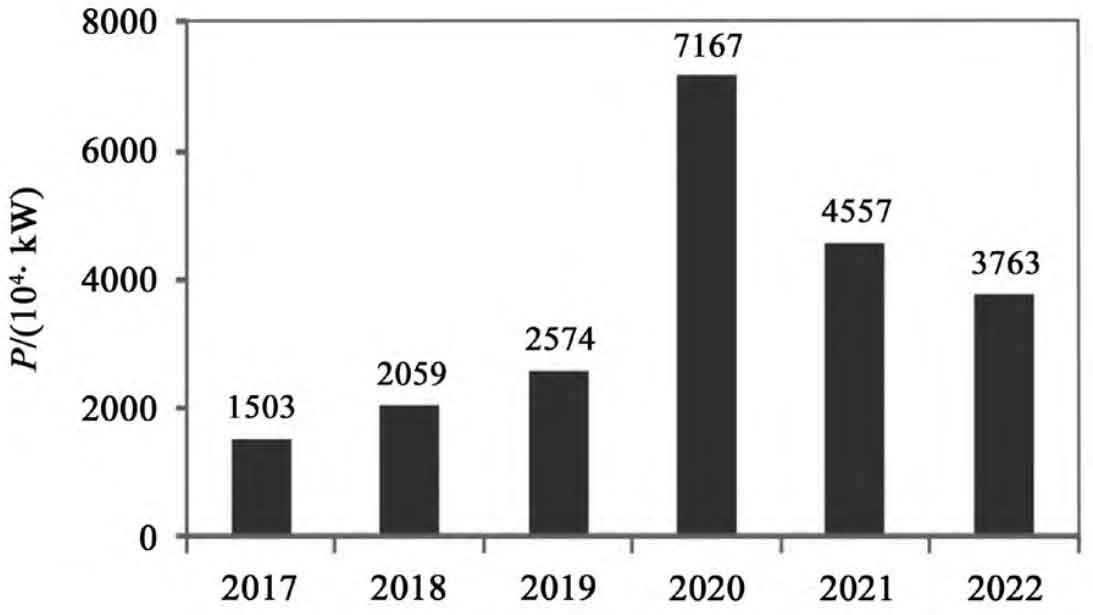
In 2021, China’s wind power generation has reached 6.526 × 1011 kWh, with a year-on-year growth rate of 40.5%. From January 2022 to November 2022, the cumulative wind power generation is 6.144 8 × 1011 kWh, with a cumulative growth rate of 12.2% (see Figures 3 and 4).
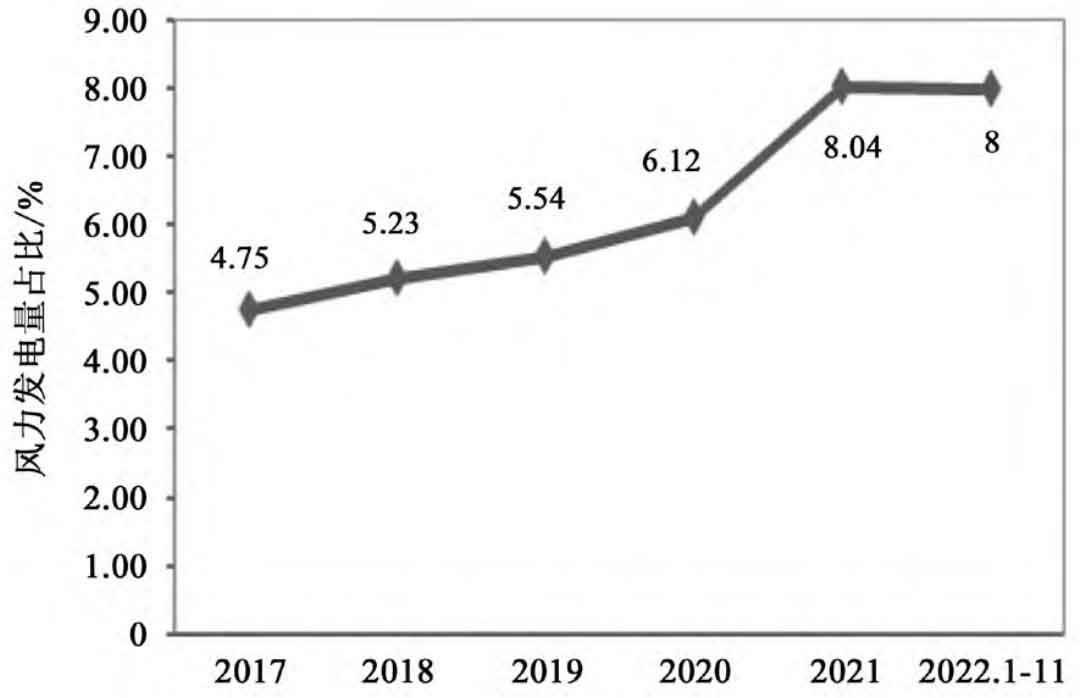
Wind power generation, as a major component of the new energy generation system, occupies an important position in the total power generation of China’s power system. In 2021, China’s wind power generation accounted for 8.04% of the country’s total electricity generation, and from January to November 2022, wind power generation accounted for approximately 8.00% of the total electricity generation. The utilization rate of wind power grid connection has remained stable at a high level. In December 2021, the national wind power utilization rate reached 97.6%. The wind power utilization rate of 18 provinces and cities, including Beijing, Tianjin, Heilongjiang, Shanghai, Jiangsu, Zhejiang, Anhui, Fujian, and Jiangxi, has reached 100%. In 2022, the utilization rate of wind power reached 96.8%. The utilization rate of wind power in 13 provinces and cities, including Beijing, Tianjin, Shanghai, Jiangsu, Zhejiang, Anhui, Guangxi, and Hainan, has reached 100% (see Figure 5). With the further development of semiconductor materials, the total amount of photovoltaic power generation is also steadily increasing year by year. The total capacity of newly added photovoltaic grid connection in 2022 is 8.740 8 × 1011 kW, with a centralized photovoltaic power station capacity of 3 629 4 × 1011 kW, with a total distributed photovoltaic capacity of 5.111 4 × 1011 kW. As of the end of 2022, the cumulative total photovoltaic grid connected capacity is 3.920 4 × 1012 kW, with a centralized photovoltaic power station capacity of 2.344 2 × 1012 kW, with a total distributed photovoltaic capacity of 1.576 2 × 1012 kW.
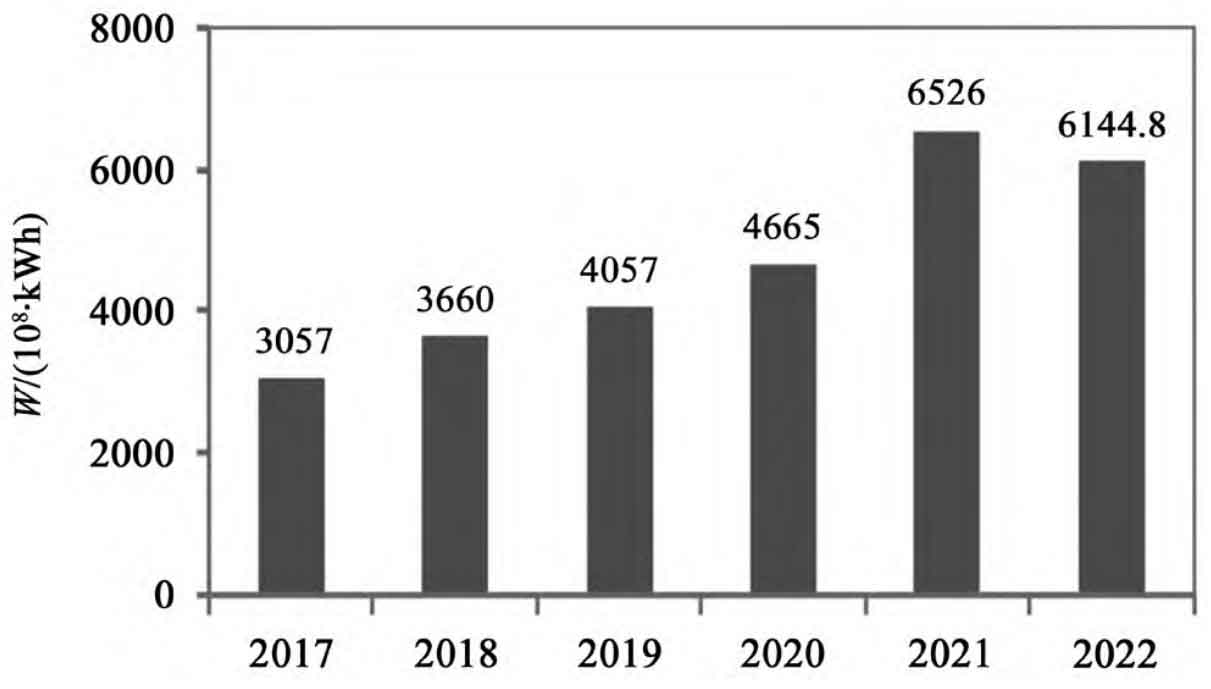
At present, the proportion of non fossil fuels in total energy consumption has increased to about 17.3%, with photovoltaic power generation accounting for about 4.2%. According to current statistical data analysis, as the country further increases its investment and layout in new energy generation technologies such as wind power and photovoltaic, the proportion of new energy generation will definitely increase and gradually replace the important role of traditional thermal power generation in people’s livelihood and production development. Therefore, it is imperative to build a new type of power system.
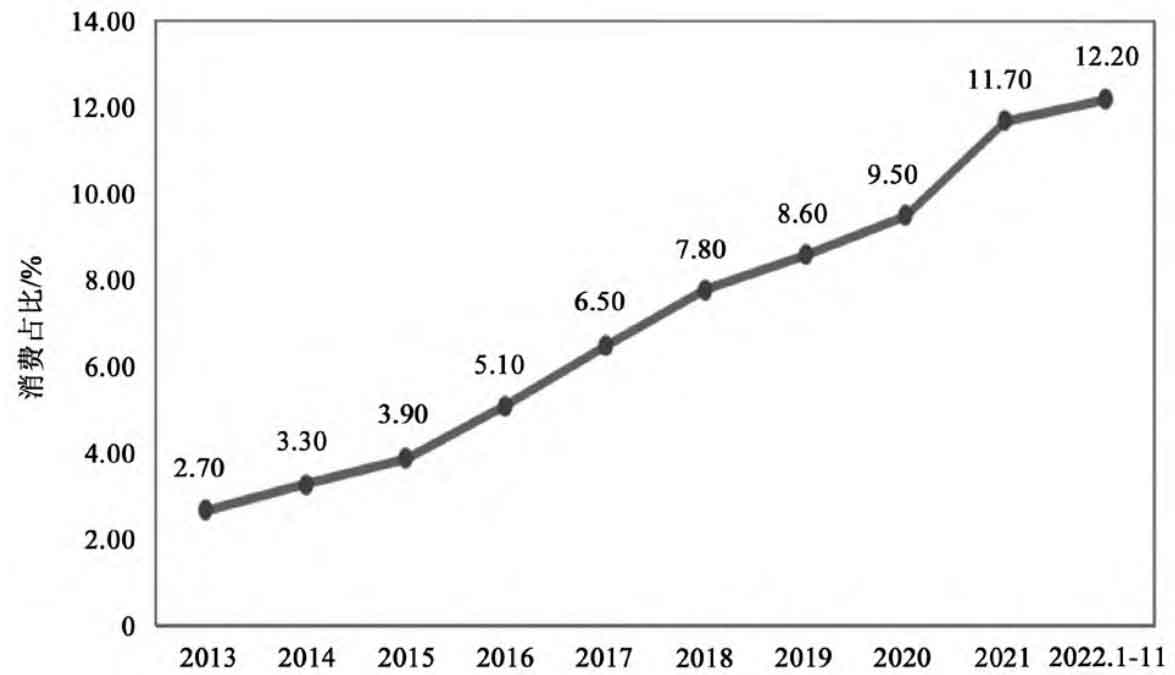
2.Development Trends of New Energy
In order to cope with the intensification of global climate change and the continuous increase in resource consumption, the development and utilization of new energy has become a common consensus among countries around the world. In the past period of time, there has been tremendous development in new energy technology. Especially in developed countries such as Europe and America, new energy has become the main source of energy, and its proportion in the energy structure is increasing day by day.
Nowadays, China has also increased its emphasis on new energy, starting to introduce new energy power generation into the power grid, continuously vigorously developing new energy technology, and focusing on building a new energy power system to alleviate the current electricity shortage situation. The country has successively introduced a series of policies, such as the “Opinions on Improving the Mechanism and Policy Measures for Green and Low Carbon Energy Transformation”, the “14th Five Year Plan for Renewable Energy Development”, and the “14th Five Year Plan for Modern Energy System”, encouraging enterprises to transition to clean energy and move towards industrial upgrading. Due to the fact that the supply side of traditional fossil fuels is currently unable to meet the increasing energy demand in China, and wind power generation is one of the most mature, large-scale development conditions, and commercial development prospects in the field of renewable energy. Therefore, vigorously developing wind power generation is of great strategic significance for China to promote the optimization of energy structure.
At present, governments in various regions with natural geographical resources such as wind energy are actively planning and laying out clean energy construction, actively promoting the development and utilization of new energy such as wind power, and promoting economic development. As of 2022, the newly installed capacity of wind and photovoltaic power generation in China has exceeded 1.2 × 108kW, breaking through 1 for 3 consecutive years × 108 kW. Wind and photovoltaic power generation exceeded 1 for the first time × 1012 kWh, reaching 1.19 × 1012 kWh, a year-on-year increase of 21%. Developing new energy is an important direction for the future, which not only has broad market application prospects, but also benefits China’s energy enterprises in completing industrial upgrading and energy structure optimization reform.
3.The Application Status of Energy Storage Technology in New Energy Power Systems
3.1 The role of energy storage technology in the field of new energy generation
Energy storage technology is the release and storage of energy through human means. Energy storage technology solves the randomness and volatility of new energy generation, effectively reducing the impact of distributed power sources on the power grid. With the continuous decrease in the construction cost of energy storage equipment, the position of the new energy industry in the power system is gradually improving. Energy storage equipment can serve as both a buffer for energy and a backup power source, which can improve the inconsistency of power transmission and transformation to a certain extent. It can effectively improve the safety and stability of the power grid, and enhance the schedulability of the power system. Energy storage devices effectively suppress the fluctuation of grid connected power of renewable energy, reduce the impact on the power grid, improve the economy of the power grid, and reduce unnecessary energy consumption.
3.2 The importance of energy storage technology for the development of new energy power systems
3.2.1 Creating conditions for large-scale use of new energy generation
Wind power generation technology and solar power generation technology are both important components of the current new energy generation system. New energy has advantages that traditional fossil fuels do not have, such as cleanliness and recyclability, but it also has characteristics of volatility and intermittency, which affect the safe and stable operation of the power grid. The application of energy storage technology can effectively improve the stability of new energy grid connection.
3.2.2 Ability to change energy supply structure
With the increasing demand for energy, the single use of traditional fossil fuels is not conducive to the sustainable development of China’s economy and can lead to serious environmental crises. To ensure sufficient energy, it is necessary to change the current energy supply structure. In the process of using new energy, based on the actual energy needs of users, scientific design of the new energy system should be carried out in a suitable way. By utilizing energy storage technology (independent or grid connected) reasonably, energy supply should be ensured and the environment should be protected.
3.2.3 Peak shaving and stable control output
The intermittent and fluctuating nature of new energy electrical signals such as wind and photovoltaic power generation is currently the main reason why new energy cannot be used on a large scale in the power grid. The use of energy storage technology is an effective means to solve this problem. Peak shaving of the power station through energy storage equipment ensures stable output in the later stage, without increasing the capacity of the power grid, and can improve the utilization rate of new energy.
3.2.4 Improving system stability and operational efficiency
The stable operation of the power system is an important indicator for confirming the safety of the power grid. During operation, the failure of any part will have an adverse impact on the safety and stability of the entire system. The use of energy storage systems can ensure effective control of faults in the power grid system, effectively suppress fluctuations in the power grid system, and achieve self-regulation through mutual coordination. In the event of a power outage in the power grid system, energy storage equipment can provide effective power supply for a period of time.
3.3 Application advantages of energy storage technology in the field of new energy generation
3.3.1 Suppressing the power of wind power grid connection
The negative impact of new energy grid connection on the power system can damage the stability of voltage. By combining energy storage technology, modeling and analyzing wind power plants, constructing effective wind light storage coordinated control schemes, regulating reactive and active power in the power grid, and configuring capacity, frequent changes in power can be controlled to stabilize the output power of grid connection.
3.3.2 Frequency of Stable Power System
The process of integrating new energy into the grid has had a negative impact on the power system – frequency fluctuations. In the case of new energy generation, adding an effective energy storage system can compensate the power system for power and ensure consistency in grid frequency. On this basis, optimizing the energy storage system can improve the lifespan of the new energy generation system, thereby reducing the production cost of the entire power system. By adding an energy storage system in the grid connection of new energy, which serves as a backup power source, the phenomenon of power interruption caused by intermittent power generation can be improved, thereby improving power supply stability.
3.3.3 Optimizing the power quality of the power system
During the grid connection process of new energy generation, voltage drop or flicker may occur, leading to a decrease in power quality. Adding energy storage equipment to the new energy system can smoothly control power fluctuations and achieve optimization of power quality. Adding energy storage devices such as supercapacitors to the new energy grid connection and regulating power quality through fuzzy logic control can further improve the problem of reduced power quality.
3.3.4 Improving the Economy of New Energy Grid Connection
Due to the variable output power of new energy sources, it is necessary to increase reserve capacity in order to improve the stability of the power system. In the process of new energy grid connection, physical energy storage methods such as pumped storage can be used to convert electrical energy into stable physical potential energy, improving the stability of wind farm grid connection operation. By combining the goal of maximizing electricity price returns with the goal of minimizing new energy output power, two corresponding new energy generation and physical energy storage schemes are formed to achieve stable regulation. This not only improves the operational stability of the power system, but also effectively reduces the cost of wind power generation investment.
3.4 Energy storage forms in the field of new energy generation
At present, the application of energy storage technology for large-scale new energy generation integration into the power system at home and abroad mainly adopts a combination of energy based energy storage and functional energy storage. Energy storage such as pumped storage, lithium batteries, and flow batteries are suitable for frequency modulation and peak shaving purposes. Power based energy storage methods such as flywheel energy storage, supercapacitor energy storage, and superconducting magnetic energy storage are suitable for real-time load smoothing and optimizing power quality.
3.5 Application forms of energy storage technology in the field of new energy generation
Energy storage technology, as one of the key core technologies in the construction of new energy power systems, is distributed throughout various stages of power generation, distribution, and consumption. Due to different applications in power systems, the value that energy storage technology brings to the power grid also varies [6]. However, in engineering practice, energy storage equipment is mainly distributed on new energy measurement, traditional power supply side, power grid measurement, user side, etc.
3.5.1 New energy side
The output power of new energy has uncertainty and volatility, which will increase the difficulty of grid connection. The energy storage system utilizes its own spatiotemporal translation characteristics of energy to improve the controllability of wind power output power and enhance the ability of new energy grid connection. Both wind power generation and photovoltaic power generation are influenced by factors such as environmental weather. By utilizing the complementary characteristics between wind and light resources and configuring appropriate capacity energy storage devices in the system, the fluctuations caused by wind and light grid connection can be suppressed, the impact on the power grid can be reduced, and the acceptance capacity of the power grid for new energy can also be improved.
3.5.2 Traditional power supply side
Traditional power sources mainly refer to thermal power that will undertake frequency modulation tasks or serve as backup power sources in future new energy power systems. According to GB/T 15945-2008 “Power Quality – Frequency Deviation of Power Systems”, the frequency deviation limit under normal operating conditions is ± 0.2 Hz. Thermal power has drawbacks such as low ramp rate and slow regulation speed during frequency modulation. The energy storage system has the ability to respond quickly and adjust in both directions. Configuring a battery energy storage system on the side of the thermal power unit to assist in frequency regulation can ensure the safe and stable operation of the power grid and extend the service life of the thermal power unit.
3.5.3 Grid side
The connection of energy storage power stations can effectively improve the peak shaving capacity of the power grid, alleviate the power supply pressure during peak load, achieve peak shaving and valley filling, smooth load fluctuations in the distribution network, ensure the safe and stable operation of the system, and improve the voltage quality of the power grid. Due to the flexibility and fast response characteristics of reactive power compensators, when severe fluctuations in active power in the power grid threaten the stability of the grid frequency, auxiliary frequency regulation by energy storage stations can maintain the stability of the grid frequency and improve the grid side system’s ability to absorb new energy. Due to the large-scale integration of distributed new energy into the power grid, the grid side covers a large number of microgrids and active distribution networks. The volatility of renewable energy sources such as wind and light in microgrids has brought negative impacts to the power system. The addition of energy storage systems can not only maintain the energy balance of microgrid systems, but also effectively alleviate problems such as wind and solar abandonment. Active distribution networks are composed of distributed power sources such as wind and light, controllable loads, and distributed energy storage. They can actively participate in operation, control, and management, thereby improving the distribution network’s acceptance of distributed new energy. Energy storage systems also play a crucial role in active distribution networks.
3.5.4 User side
Energy storage devices can enable users to store or release energy independently or through external scheduling control, and charge and discharge electricity in different periods according to the time of use electricity price policy for profit, reducing user electricity bills. When the power load is at its peak and the electricity price is high, users use energy storage devices for discharge to maintain their own electricity demand. When the power load is at a low point and the electricity price is low, users use energy storage devices to store their energy, thereby achieving peak shaving and valley filling, reducing the pressure on the grid during peak loads, and reducing user electricity costs. When users participate in demand side response and adjust the power grid, the integration of energy storage systems can improve their ability to participate in demand side response. When users achieve spontaneous self use and use excess electricity online, it is easy to experience insufficient electricity. At this point, the energy storage device serves as an uninterruptible power supply, which can improve the reliability of power supply. When the power generation device is at its peak output, electrical energy is stored through the energy storage device; When the power grid is at peak load, the electricity price is high, and the energy storage device is discharged. Users can use surplus electricity to connect to the grid while meeting their own electricity needs, thereby gaining profits.
4.Application methods of energy storage technology in the field of new energy generation
The above content discusses the application scenarios of energy storage equipment in the power system and analyzes the unique advantages of energy storage technology in stabilizing the grid connection of new energy generation. How can energy storage technology be applied to the new energy generation side and leverage its unique advantages? Based on the actual engineering situation on the power generation side, there are generally three ways to achieve this:
4.1 Method 1
When frequency deviation occurs, by utilizing the frequency regulation principle of synchronous generators and the combination of speed regulators and deviation rates, the power output of the generator set is changed to quickly complete a frequency regulation. Subsequently, secondary frequency modulation is carried out, and the response of frequency modulation is controlled within milliseconds using a new energy storage device with power electronic converter, which can ensure that the frequency of the electrical signal is stable at the standard value and achieve good frequency modulation effect.
4.2 Method 2
Combine the generator set with the energy storage device to simulate a virtual synchronous generator set. This allows for the transfer of traditional synchronous frequency modulation models using a virtual frequency modulation model platform. Add an energy control system to the energy storage system to enable the virtual model algorithm to run and achieve peak shaving and frequency regulation of the energy storage system for new energy grid connection.
4.3 Method 3
By utilizing the unified control of power grid dispatching, peak shaving and frequency regulation can be achieved. The energy storage system completes corresponding instructions under the command of scheduling, combined with the active and reactive power values of scheduling, and then adjusts and controls the power output or absorption of the power grid. Due to the complexity of the algorithm for single frequency modulation and peak shaving, the difficulty of regulation can be further reduced when using the power grid for assistance.
This article introduces the development trend of new energy in recent years and the application forms of energy storage technology in new energy power systems. By analyzing the role of energy storage technology in new energy power systems, some general feasible methods for the application of energy storage technology in the field of new energy power generation are obtained.
With China vigorously developing clean energy technologies such as wind power and photovoltaic, steadily advancing the node goals of “carbon peaking” and “carbon neutrality”, and focusing on building a new type of power system led by clean energy, energy storage technology, as a key technology for grid connection of new energy power generation, will definitely welcome broad application scenarios.
